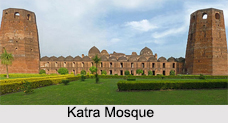 Located in the north eastern city of Murshidabad, the Katra Mosque was built between 1723 and 1724. The mosque houses the tomb of Nawab Murshid Quli Khan, who is buried under the entrance staircase. Currently, the mosque is maintained and protected by the Archaeological Survey of India and the Government of West Bengal.
Located in the north eastern city of Murshidabad, the Katra Mosque was built between 1723 and 1724. The mosque houses the tomb of Nawab Murshid Quli Khan, who is buried under the entrance staircase. Currently, the mosque is maintained and protected by the Archaeological Survey of India and the Government of West Bengal.
Etymology of Katra Mosque
The word Katra means bazaar and close to the mosque there used to be a market place, hence the name Katra Masjid or mosque.
Architecture of Katra Mosque
The Katra Mosque was built by an architect named Murad Farash just within a year. The mosque stands on a 54 meter high square plinth and is surrounded by a row of double storied domed cells which form a cloister to the spacious courtyard in its front. These domed cells can also be called a Madrasa, which can accommodate about 700 Quran readers. There are 4 octagonal big minars tapering upwards which stands at the 4 corners. There are 2 minars or minarets at the entrance of the mosque measuring about 70 feet in height and 25 feet in diameter. The mosque is quadrangular in shape and has 5 domes, of which the two next to the central have collapsed after the great earthquake of 1897 AD. Each minar has a winding staircase which leads to the top and a major part of the city of Murshidabad can be seen from here. The mosque is spread over an area of 19.5 acres and the facade is decorated with rectangular panels, battlements and corner minarets.
The entrance to the mosque is by 14 flights of stairs from the east, Nawab Murshid Quli Khan has been buried under these stairs as an act of humility, so as to be trodden on by all who passed up and down. In the mosque there is a slab embedded at the top where it is written in Arabic: "Muhammad, the Arabian, the glory of both worlds. Dust be on the head of him who is not the dust of his portal ".
Visiting Information on Katara Mosque
The Murshidabad railway station is at a distance of 3 km from the mosque. And the Netaji Subhas Chandra Bose International Airport is the closest at a distance of 192 km from the mosque.





















